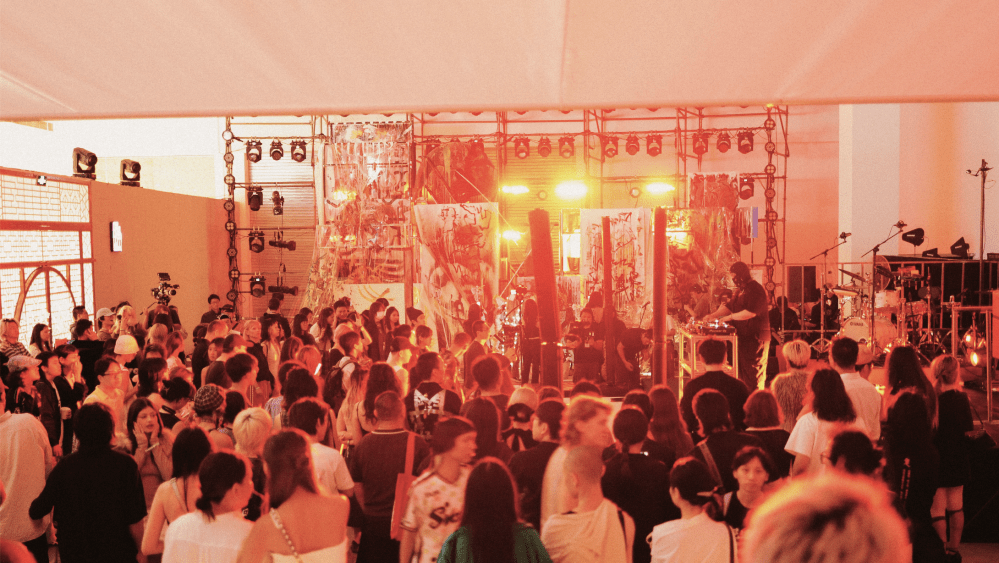Exploring the art form of museum-based performance, Chanel has unveiled “Theater,” the third season of the Next Cultural Producer program, established in collaboration with Power Station of Art, the Shanghai-based contemporary art museum and one of Asia’s largest.
This year’s winning proposal, tiitled “Noon, Wildness, Stream, Washe, Ruins, Theatre,” was curated by the Hangzhou-based artist group Martin Goya Business and opened on July 12 with an unconventional performance that brought together 150 art activists and lasted for eight hours.
A scene from the opening performance.
Courtesy
The exhibition, split into several sections, juxtaposes ancient Chinese architectural forms — such as a Song Dynasty entertainment venue and latticed paper windows — with a symphony of moving images, poetry, crowd-sourced documents from its artist community, and graffiti-like paintings. Together, the exhibition disrupts the museum’s white cube setting and sets the scene for its anachronistic storyline.
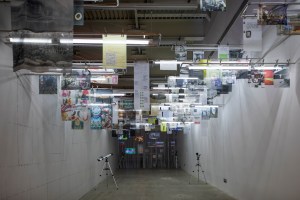
Inside “Noon, Wildness, Stream, Washe, Ruins, Theatre.”
Courtesy
On opening night, members of the local artist community — including students, deejays, dancers, emerging talents, and established names — came together for a dynamic performance, or “continuous collective action,” that culminated in a midnight mini-concert by avant-garde rock band Mola Oddity, fronted by former Taiwanese pop star Amber Kuo.
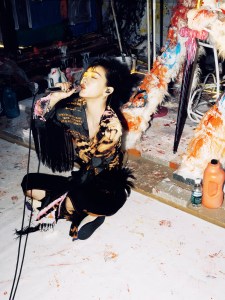
Amber Kuo performing at PSA.
Courtesy of Mola city
“The eight-hour duration [performance] is meant to transcend time by exploring different modes of viewing, including how we perceive things in ancient times versus now,” said Cheng Ran, co-founder of Martin Goya Business, during a panel discussion on Sunday.
“It creates small transformations and frees people from the comfort of familiarity, guiding them towards a more spiritual or contemplative one. You can’t explain the space in a fixed framework; perhaps this is our way of grasping small freedoms,” Cheng added.
Cheng also emphasized that the art institution should “bear witness to emerging artistic careers, rather than serving as the last stamp of approval,” he added.
The four-person artist group, established in Hangzhou eight years ago, is led by Cheng, co-founder Da Mian, a Chinese martial arts fantasy novelist; Taoph, a visual and music curator; and Tan Sin Thiau, a writer.
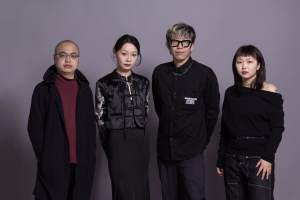
Members of Martin Goya Business, Tan Sin Thiau, Da Mian, Cheng Ran, and Taoph.
Courtesy
The group, named after one of the 24 cats owned by the group, exists as an outlier from the traditional art system and aims to support, promote, and engage within the local Hangzhou artist ecosystem. It has curated more than 100 events, collaborated with some 400 trans-disciplinary creators, and held exhibitions across 20 countries.
Its latest invention involves a canteen-style restaurant, which turns into a bar operated by artists at night. “The artist community needs to find a sustainable way to build up a community. We have to eat, we can’t exist in a vacuum,” explained Da Mian.
Triggered by Hangzhou’s rapid urbanization, the group had to relocate four times until it found its current studio in the outskirts of the Shanghai-adjacent city. That experience informed a two-story-tall scaffolding structure where 12 artists took turns live-painting, the latter’s work overlaying its predecessor’s.
“Most art exhibitions focus on showcasing the finished painting, but I wanted to present a scene very familiar to painters, the ruins, or the remnants they encounter during the process of relocating their studio. I believe many artists face the same dilemma. Where do you rent a studio and how long can you keep it? In Hangzhou, we are constantly exploring the city’s boundaries as it expands. Each time the city grows, we inevitably face relocation, sometimes even collective relocation,” said Da.
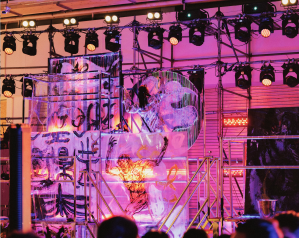
The action-painting.
Courtesy
“When we are confronted by the complex task of moving, which often involves packing up several years of personal work, we have the urge to claim the space our own again. Oftentimes, artists come together, armed with flashlights, sneak inside to make music, to perform, or paint,” added Da.
In the next three months, 1,500 gigabytes of performance footage captured by ten cameras during opening night will be edited down and displayed at the exhibition.
“We had a loose script for the exhibition, but we left it largely open, so the video has to portray the collective creative process; its visual representation needs to be constantly evolving,” explained Da.
The free exhibition is open to the public until Sept. 8.
Co-founded by PSA and the Chanel Culture Fund in 2021, the Next Cultural Producer initiative marks the company’s first partnership with a museum in Asia. The program’s previous two seasons shed light on Chinese craft and architecture in Southern China.
Last May, Chanel signed a strategic partnership with PSA to restore the museum and enrich its collection and research capacity.
PSA is the first state-run contemporary art museum in mainland China. Located in a former power plant along the Huangpu River, the museum spans more than 441,000 square feet and opened in 2012.
